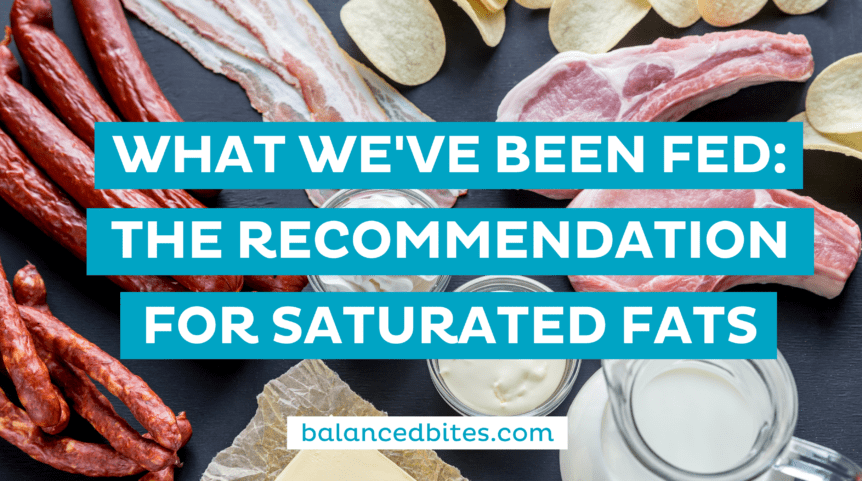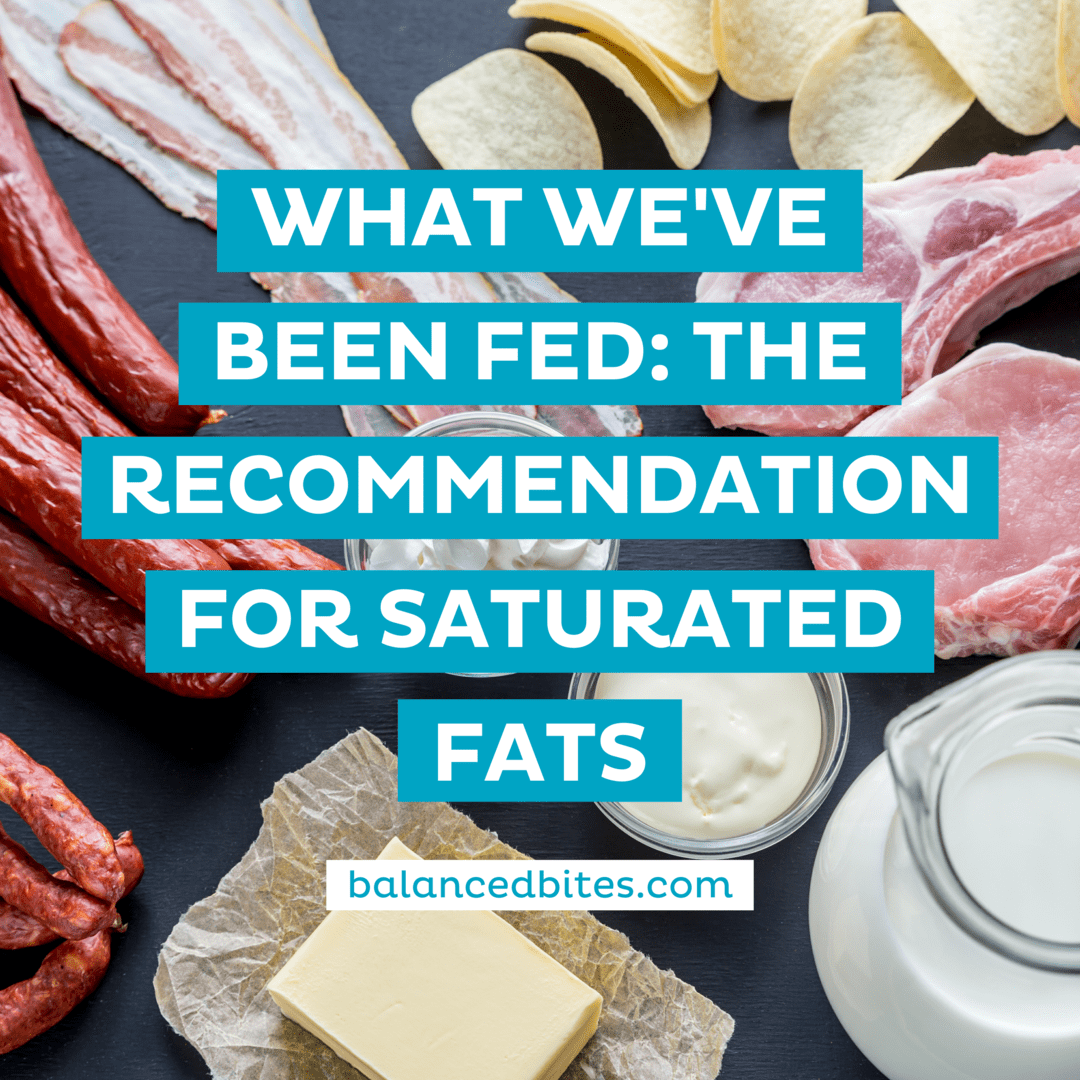In this series, I'm sharing some excerpts from my book, “Practical Paleo” with you.
You may or may not choose to follow a paleo style of eating, it isn't required to be healthy.
But, many of you have told me you've benefitted from eating paleo for a short or long period of time, so these posts will explain more of the premise behind paleo eating for those curious.
Further, while I don't currently educate publicly about the paleo diet, you can always read a lot more and get over 100 easy paleo recipes in “Practical Paleo.”
Here's what the USDA has to say about Saturated Fats in our diet…
“A healthy eating pattern limits saturated fats.”
The USDA recommends avoiding saturated fats because they say there is evidence that eating less saturated fats “is associated with reduced risk of cardiovascular disease,” especially higher blood cholesterol levels. The truth about saturated fat consumption is that it’s never been shown to cause cardiovascular disease (CVD). What we have seen is that there seems to be a correlation between a diet higher in saturated fat and incidence of CVD. But this correlation appears in observational studies, not randomized, controlled trials, which are truly the only way to determine cause and effect. Recall that correlation does not equal causation (see page 29 in Practical Paleo). This is so critical to understand when talking about broad-sweeping claims regarding nutrition and health and the bold, often fear-based headlines we see in the media.
While it’s true that naturally occurring saturated fat—from sources like egg yolks and coconut oil—can raise “good” (HDL) cholesterol, this is not cause for alarm. These fats may actually help prevent coronary artery disease, according to a 2004 study. Furthermore, increasing HDL is generally understood as a good thing, since higher HDL may mean a lower risk of CVD. And eating foods that support cholesterol production actually helps your body, which needs the fuel to manufacture cholesterol.
Furthermore, high blood cholesterol levels have not been proven to cause heart disease. In fact, many who experience CVD have low cholesterol! Dr. William Castelli, a former director of one of the longest-running dietary studies in existence, the Framingham Heart Study, reported that “people with low cholesterol (lower than 200) suffer nearly 40 percent of all heart attacks.” According to Dr. Castelli, “In Framingham, Mass., the more saturated fat one ate, the more cholesterol one ate, the more calories one ate, the lower the person’s serum cholesterol. . . . We found that the people who ate the most cholesterol, ate the most saturated fat, ate the most calories, weighed the least and were the most physically active.”
And here’s some more good news about saturated fat: the more saturated fat you eat, the less likely you are to suffer a stroke. Your risk of stroke decreases by 15 percent for every 3 percent increase in your saturated fat intake.
So then, what does the USDA consider a healthy source of fats? Oils! Specifically, they encourage the use of oils high in polyunsaturated fats (PUFAs), such as corn, soybean, and cottonseed oils, as well as those high in monounsaturated fats (MUFAs), such as olive, canola, peanut, sunflower, and safflower oils. In a nutshell, highly processed oils, especially those high in PUFAs, are less stable and more prone to becoming damaged (oxidized and rancid), particularly during cooking. Fatty acids from the foods we eat are incorporated into our cell membranes, so avoiding poor-quality or damaged oils can help prevent cellular damage.
The Guidelines also recommend seeking out “lean or low-fat versions of meats, poultry, and dairy products.” We’ve already talked about the problem with low-fat dairy products— vitamins A, D, and K2 are fat-soluble, so we actually need fat in order to absorb them, and processing raw milk into low-fat or fat-free products simply wastes these nutrients. What’s even worse is that getting rid of fat means getting rid of flavor, and to compensate, food companies add sugar to low-fat and fat-free foods.
The first Dietary Guidelines for Americans was created in the late 1970s, nearly twenty years after initial claims were made that dietary fat and cholesterol are harmful to our health. At the same time, an even more exciting development arose: the amount of fat used in many processed products could be reduced while still preserving flavor and palatability through the use of (you guessed it) high fructose corn syrup! Oh boy.
The number of low-fat and fat-free profit-earning products began to snowball. Fat- free cookies, “light” yogurts loaded with sweeteners, fat-free puddings, and low-fat “buttery spreads” hit their stride, filling our cupboards and refrigerators and crowding out the natural foods that could be made from scratch in every kitchen in America. We fell prey to the desire for convenience and sweet taste, helped along by food companies’ marketing, and as a nation, our waistlines grew and our internal, metabolic physiology became unbalanced.
Sadly, the recommendation to avoid saturated fat is likely a result of massive lobbying by the vegetable oil industry, which benefits whenever we use their industrial products rather than natural animal fats.
Know this: The science does not support the demonization of saturated fat. The USDA is wrong, and their recommendations have made the refined seed oil industry lots of money while we’ve run scared from eggs, bacon, and butter.
What may be more accurately associated with CVD are trans fats, which are often lumped together with saturated fats in dietary recall studies. We know man-made trans fats are dangerous, but why must natural saturated fats like those in egg yolks, well-raised meats, coconut oil, and grass-fed dairy products take equal blame when their chemical structures and origins are entirely different? People all too often assume that the naturally occurring forms of saturated fats are also harmful—quite possibly due to media reporting that continues to promote these notions. The reality is that the chemical structure of a short- or medium-chain saturated fat—from butter or coconut oil, for example—is easier for your body to break down and digest than artificial and even natural polyunsaturated fats. Why? Because they place less demand on bile salts, which the body uses to break down and utilize fats.
Know this: Man-made trans fats and refined seed and vegetable oils (canola, soybean, corn, and cottonseed oils, to name a few) are not healthful and may even be considered toxins.
We Cannot Improve What Nature Provides
Refining foods to “improve” them is oxymoronic at worst and nonsensical at best.
We can only hope the government will step aside and allow proven nutritional science and common sense—not food industry lobbyists or alarmist health claims—to prevail in the field of public health.
The more you follow the USDA’s recommendations, the more processed foods you’ll have to buy. You can’t possibly eat all of those servings of grains and low-fat dairy without eating breakfast cereal, low-fat milk, or low-fat yogurt, can you? When you follow those suggestions, many large corporations make lots of money from your dietary “choices,” and they don’t have to spend much to produce the stuff. In fact, many USDA-compliant items are made with the cheapest and most subsidized commodity food items, such as corn, wheat, and soy. Sometimes you’re the one eating these commodities, sometimes it’s the dairy cow. Either way, you’re the end consumer.
Yes, this includes that innocent-looking light yogurt with the alluring ads describing fantastically indulgent flavors and high fructose corn syrup in the list of ingredients. (I should know because I used to down those puppies like crazy.)
No wonder everyone is confused about what to eat! But don’t worry. Take a flip through Practical Paleo, & you’ll have the tools you need to navigate the modern food landscape.

If you missed the intro to this series, you can find it here. The rest of the series can be found here:
The USDA Recommendation for Grains
The USDA Recommendation for Legumes
The USDA Recommendation for Dairy
Stay tuned for final post of the series on cholesterol, coming next week.



Comments 4
Wonderful article! Very detailed and informative. Thank you for sharing!
Pingback: What We've Been Fed: The Recommendation for Cholesterol | Balanced Bites | Squeaky clean heat-and-eat meals | Organic Spices | Created by Diane Sanfilippo
Your post was very informative, I didn’t know much about saturated fats and the connection with the food we eat . Base on your post, my opinion is that the USDA needs to focus more about the unprocessed food that we eat and stop forcing those process ones. I am always amaze to see that the most unhealthy food at the grocery store are not only the cheapest but also they are display at the forefront of the store while the food that we should be eating are in the back mixed with all the others. we need to normalize healthy eating.
Pingback: What We’ve Been Fed: The Recommendation for Saturated Fats | Balanced Bites Wholesome Foods, Diane Sanfilippo – Just another WordPress site